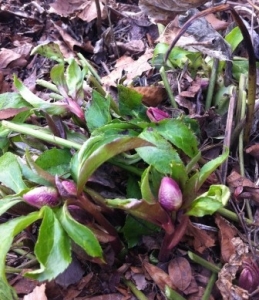
After a long dreary winter, the first flowers of spring are all the more welcome. Everyone knows crocuses and daffodils, but there are some lesser known beauties that are also worth planting for their early appearance of beautiful blooms.
Winter aconite, Eranthus hyemalisis, one of the first. It is a yellow flowering bulb that should be planted in the fall. It does well under deciduous trees or shrubs so it receives full sun until early summer when it goes dormant. Plant these little beauties where they can be seen along walkways or from a window.
Another late winter favorite is hellebores or Lenten rose. Since being named as Perennial Plant of the Year in 2005, the breeding and availability of this winter bloomer has skyrocketed. Like winter aconites, hellebores like a shady home in the garden. At our house they are tucked between the porch and some azaleas. Clean up tattered evergreen foliage before the flowers start to emerge in February or early March. I scraped some snow away today and saw the buds reaching upwards. Flowers come in shades of white, pink, and reddish purple. While several species are common, the H. orientalis hybrids seem to be the easiest to grow.
Witch hazels, a small flowering tree, are also a harbinger of spring. Their spidery, fragrant flowers in yellow, orange or red make a nice focal point in a mid to large yard. Cut branches of the fragrant flower to bring the outdoors in.
Snow drops, crocuses and scilla are all spring blooming bulbs that when planted in the fall, will reward you with beautiful early flowers. All three of these are very hardy, and will naturalize over time. When clumps get too large, dig some up and move to expand the bed- or give some to a friend.
One last early spring pick. Pasque flowers or pulsatilla, are one of my favorites. They bloom the same time as daffodils, late March in a normal year. The flowers have dark purple or red petals with a bright yellow center. Once the bloom is gone, their intriguing seed head are left, looking like a puff of smoke. Great for full sun in rocky or poor soil, these are tough little beauties.
If you are like me and are getting sick of the white stuff, take a look around you garden to be reminded that spring is coming. As my winter-loving uncle recently reminded me, we’ll be sweating in the sun soon enough.
 My love affair with the large oak trees in my yard continues to grow. After the ice storm a quick survey of my yard netted five small limbs. One came off a large maple, two from wild cherries edging the yard, a birch sapling that broke at ground level and a sassafras sapling that broke off about ten feet from the ground.
My love affair with the large oak trees in my yard continues to grow. After the ice storm a quick survey of my yard netted five small limbs. One came off a large maple, two from wild cherries edging the yard, a birch sapling that broke at ground level and a sassafras sapling that broke off about ten feet from the ground.